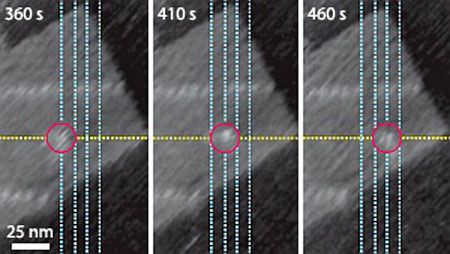|

28 March 2011
from
NatureAsia Website
|
The controlled displacement
of an artificial molecular transporter may lead to
ultra-small DNA assembly lines. |

AFM images showing
the movement of
a DNA motor along a DNA track.
Molecular motors play a crucial role in
many important biological events, such as the separation of
chromosomes in cell division and assisting the transcription of
DNA
into
RNA.
Inspired by these sophisticated devices,
researchers from Kyoto University in Japan and the University of
Oxford in the UK have now developed a method for generating a
synthetic molecular transport system using DNA.1
Taking advantage of the one-of-a-kind ability of nucleic acids to
form specific hydrogen bonds, the collaborative team led by
Andrew Turberfield and Hiroshi Sugiyama has exploited DNA
strands to create track components, motor and fuel for this
transport system.
“DNA is a uniquely flexible material
that allows the exploration of self-assembling molecular
structures and devices,” says Turberfield. “This is because the
interactions between components can be programmed very easily
using the natural specificity of base-pairing.”
In this all-DNA system, the researchers
monitored the motion of a single strand of DNA that acts as a motor
on a track.
To manufacture the track, they
immobilized 15 single DNA strands known as stators on a raft-like,
rectangular DNA origami tile consisting of double helices stitched
together through short double-stranded DNA ‘staples’. These stators
are complementary to the motor, which hybridizes to one of them,
forming a double helix.
To fuel the transport system, the team opted for a ‘nicking
restriction’ enzyme that cuts a fragment off the end of the
motor-stator double-helix.
Turberfield explains that the
dissociation of this fragment causes the motor to migrate to the
next stator where it can bind more strongly because of the increased
number of base pairs, allowing the cycle to repeat.
“This is described as a ‘burnt
bridges’ mechanism because the track is destroyed as the cargo
passes,” he says.
Fluorescence imaging and atomic force
microscopy (AFM) revealed that the motor travelled in a controlled,
linear 16-step movement over a large distance. The AFM imaging
(pictured above) captured the motor stepping down the track in real time.
The researchers believe that this controlled motion can be used to
direct molecular assembly, producing a nano-scale production line.
“We are now working on programmable
systems that function autonomously and can navigate complex
systems of tracks,” says Turberfield.
Reference
-
Wickham, S. F. J.1, Endo, M.2,3,
Katsuda, Y.4, Hidaka, K.4, Bath, J.1, Sugiyama, H.2,3,4 &
Turberfield, A. J.1
Direct observation of stepwise movement
of a synthetic molecular transporter. Nature Nanotechnol. 6,
166–169 (2011).
Author
affiliation
-
University of Oxford, Department
of Physics, Clarendon Laboratory, Parks Road, Oxford OX1
3PU, UK
-
Institute for Integrated
Cell–Material Sciences, Kyoto University, Yoshida-ushinomiyacho,
Sakyo-ku, Kyoto 606-8501, Japan
-
Core Research for Evolutional
Science and Technology, Japan Science and Technology
Corporation, Sanbancho, Chiyoda-ku, Tokyo 102-0075, Japan
-
Department of Chemistry,
Graduate School of Science, Kyoto University,
Kitashirakawa-oiwakecho, Sakyo-ku, Kyoto 606-8502, Japan
|

